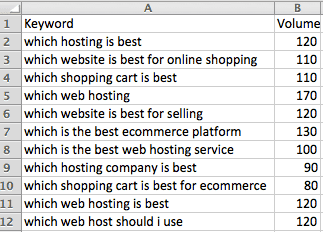27 White Hat Search Experts Best Practices To Rank #1
What is White Hat SEO?
White hat tactics refer to practices that follow the terms and conditions of the major search engines, especially Google. The end goal is to increase your website rankings, without building a site that is focused on manipulating algorithms.
When referring to Search Engine Optimization (SEO) terminology, White Hat SEO refers to techniques and tactics that focus on giving the human audience a good, relevant experience, rather than using tactics that trick search engine results in an attempt to manipulate their rules and policies.
By focusing on people first, and search engines second users are better served.
The goal is to organically rank based on the quality and authority of your website. In making a long-term investment on your site, the results will pay off long term.
Want to stay on top of the SERPs?
Want the big secret? My take and philosophy is that the best website wins long term. Links, of course, play a considerable factor in rankings, and I will get to that.
Sure, you can take shortcuts, but we all know where that leads.
I do not work with clients who are not on board with my philosophy of focusing on user experience by building out the best website, period.
I break down my top 5 at the bottom of this post.

Andrew Provost
1. Context versus content – it’s easy to say content is king but search engines now are looking for context and understanding user intent. Make content purposeful and addressing pain points, providing useful information and educating your public. Use tools like soovle.com and answerthepublic.com to determine what queries are commonly asked by people willing to not only purchase goods or services but also advocate your brand. Brand recognition is more intertwined with parlaying into non-branded keyword rankings.
2. Video content is becoming more readily digestible, and the creation of compelling video content leads to the development of multiple assets for different audiences. Your brand can generate a great video which can be converted into audio, infographics, slideshows and a blog post from one single idea. The future will bode well not only for video but live streaming which will leave areas for more interactive content generation for those that want to participate with others. Live streaming creates social interactions that in real-time and can open up conversation and idea sharing not commonly found on simple comment threads.

Cobus van Vuuren
1. One of the things I focus on is doing things that are harder for others to imitate or top. That means, investing time and money to making something that people will naturally share and link to.
Everybody talks about evergreen content, but what I prefer is to create exclusive tools, apps, and plugins. Even legitimate eBooks though that takes me longer, at least in my case. Investing in the creation of great tools will naturally improve my SEO. How? People need it, and they will want to cover it (interviews and links from blogs), and they will share it on social media (especially if you use viral loop strategies.)
For example, I tested this strategy with a schema plugin years ago which brought me a lot of coverage and links. I‘ve then moved on to apps and other tools. I’m not saying that evergreen content isn’t worth it anymore because it still does.
2. Invest in something that your base needs, and you’ll naturally see significant returns, rankings, and traffic.

Sean Si
1. Optimize for Voice Search – The emergence of AI Assistants and the increase of mobile users have helped establish voice search as a way of delivering queries on search engines. With this in mind, it is best to have your website accommodate to voice searches.
Unlike regular typed search queries, voice searches are more exact and usually come in the form of questions or sentences. Users prefer to look for answers and suggestions when using voice search, and helping them by providing them instant answers would help increase organic traffic to your website.
2. Make Use of The Virtual Tour – Establishments like hotels and restaurants are some of the most searched businesses on Google, and users want to have an immediate impression on the quality and services of the location. These users rely on the images that they see and the reviews of customers and clients. When it comes to images, another factor that can affect their decision is a virtual tour.
A virtual tour allows users to take a look inside and see what a business has to offer. For example, users would be able to see hotel reception rooms and see if it fits their event, or get a feel for the ambiance of a restaurant. With an abundance of choices available for the user, it is always a good thing to find a way to stand out.
3. Increase the Amount of Video Content – Video is one of the most viewed forms of media during the past year, and there have been many businesses and brands that have followed suit and created more video content to increase their presence on the internet.
This is evident on social media, where users prefer viewing posts with videos and images. With sites like YouTube providing countless hours of video content to users across the world, creating quality videos for your website would do wonders for your search rankings and traffic. YouTube SEO is another way of promoting your brand in a highly competitive site that is accessed by millions of people on a regular basis.

Kellen Kautzman
1. Pinterest + Youtube + Video
Using Pinterest and YouTube to post images and video related to your business allows you to create your own backlinks, control the quality of your content and simultaneously reap SEO rewards.
Pinterest is the second largest referrer of traffic to websites, which means that only Facebook refers more site visits. In 2015, Google created an artificial intelligence platform called RankBrain, which is very accurate at recognizing images. On Pinterest, when you link an image back to your website, it counts as a backlink, and that link can be measured in Google’s search console. Furthermore, every time the image is re-pinned (shared), the link duplicates. This means a picture that is relevant to your business can create hundreds of backlinks, which is huge for SEO and rankings.
2. Video Content on Youtube
Many people are not aware that every English word spoken on YouTube is understood and measured by Google’s RankBrain. If you want to expand your SEO, creating video content and posting it on YouTube can be a substantial resource.
Here are a few key points for utilizing YouTube videos to increase your rankings:
- Always include annotations that link back to your website.
- Edit the closed captions.
- Add a link to your site in the description.
- Embed the video in a blog on your website and share it on social media.
- Share the blog with your email lists.
- Always ask viewers to subscribe and like your videos.

Tom Pick
Two of the biggest changes in search this year is Google’s move to mobile-first indexing and the increasing importance of voice search (longer, more detailed search queries). With that in mind, here are four areas SEO pros should focus on.
1. Make sure your site works great on mobile devices. That means fast load time, great mobile display, easy navigation.
2. Make sure your content answers questions. Look at sites like answer the public and Quora for examples of popular (but not TOO popular) questions to answer.
3. Write lists posts (but don’t over-do it). A well-done list post has a better chance of getting your site to "position zero" on Google (in Featured Snippets).
4. Make sure your technical SEO is bulletproof. While hierarchical navigation, an XML sitemap, fast load time, and the absence of broken links will not guarantee you high rankings, the absence of any of those things will hurt.

Joe Goldstein
1. If you’re competing locally, prioritize your Google reviews. A study from late 2017 revealed that Google reviews have a stronger impact on local SEO than anyone expected.
Not only do they build trust with consumers and build relevancy through keyword usage, but the sheer number of positive reviews also appears to be a direct ranking factor.
2. Blog about your community, not your industry. Instead of writing another blog post about getting your teeth whitened or the benefits of a 529 plan, try writing about people, places, companies, organizations, and events in your community.
Bloggers will quickly find that this kind of content is much more engaging, shareable, and is much more likely to gain links without outreach. You can also combine this with ego bait to gain more links, or promote it on Facebook for massive reach with even the smallest budget.
3. Review your indexing. If your website is like most, the chances are good that Google has indexed more (or less) pages than you would expect.
Search for your domain with a site: search operator to see all pages they‘ve indexed, and then check that number against the indexed page count in your search console and sitemap. If they have not indexed enough pages, make sure those other URLs are crawlable, indexable, and linked to from somewhere else on your site. If they have indexed too many pages, go through the search results to find the pattern.
Typically you might find a few pages of demo content, a few blank pages, and maybe a few pages that were indexed twice from different URLs, such as HTTP and https versions, WordPress tags that include one post each, and so on. The closer your indexing matches your actual site, the better your SEO returns will be.

Marissa Ryan
Organic SEO is mostly about creating content and adding value to the user and audience in a clean and social-forward way.
If you‘ve heard it once you’ve heard it a million times: Content is (still) King. These days, search engine algorithms are very much able to distinguish between short, keyword-stuffed content and well-written long-form content. You should use content as a chance to show off your subject matter knowledge to potential clients and customers.
1. Long Form Content is Better.
It’s been proven that long-form content increases engagement rates and time on site rates. Long form content allows for more content and stronger ideas. Shoot for 1000 - 2500 words, and link out to several sources.
Bonus: Reach out to the sources you use (Twitter is my favorite method) and invite them to read your content. They are likely to read it, and if you‘re lucky, they’ll share it on their channels.
2. Create a Matrix-like Content Strategy.
Avoid rewording the same piece of content over and over again on your blog.
Google‘s algorithms are now able to understand what’s called Semantic Search, which is the concept of understanding higher level context of both searches and of content found online.
For example, a garden center that wants to rank for gardening keywords should not only write about the best time to plant specific flower varieties but should also post about soil types, new types of ceramic, recipes made with food from the garden, etc.
Rather than just sticking to a singular subject, expand your content to cover topics that are related to your industry. A great way to come up with ideas for this is a bubble map.
3. Use Local Keywords to Your Advantage.
If you have a brick and mortar location, use local keywords in your content, and write content that will connect with local readers. This works well in larger cities that have a specific personality, or small towns that have their own quirks. The idea is to create a sense of relatability for the reader and to help you to rank for local searches.
Search engines want to serve their users with the results that are most relevant to them. It is likely that that user is on their mobile device, which means that local searches are likely to be vital to them.

Eugenia Lebedynska
It‘s all about the user these days and this is great! I’m happy to see
White Hat SEO’s moving away from manipulative techniques.
Search engines, especially Google, try hard making result pages (SERPs) as valuable as they can, and these are absolutely must-have things to succeed in SEO efforts in 2018 and in the future:
1. Optimize your website for mobile.
The percentage of mobile users is growing each year, and since 2017 Google’s Mobile First Indexing was slowly rolling out. Statista reports almost
45% of US website audience was mobile in Q4 2017.
Of course, the ratio of mobile users vs. desktop varies from niche to niche, and in some niches, the percentage of mobile users reach 70%. I wouldn‘t advise risking losing about 50% or more of your audience due to poor mobile optimization. Especially if you’re in the ecommerce industry.
Fortunately Google Page Speed Insights Google Lighthouse, and Google Testing Mobile Website Tool are here to help.
2. Optimize your page speed.
Google says 53% of users leave the page if it doesn‘t load in 3 seconds. Page loading speed is a hot topic for every website owner over 2 years already. And if Google mentioned it is important - it is a ranking factor. There’s a choice - whether to lose over 50% of traffic and witness a ranking drop OR to gain both. Google Page Insights, Google Lighthouse and Google Test Mobile Website are also useful here.
3. Mind website architecture and UX.
Surprise? No? Don’t forget about CRO checklist as well, which is very much compatible with SEO checklist.
Putting things in the right places and the right order will help your visitor browse through a website without having a headache. Put your users‘ comfort first and gain points in longer sessions, returning visits (read loyalty), and a precious conversion boost. And yes, quality website structure and correct pages’ hierarchy is a good sign for Google.
4. Satisfy the searcher’s intent.
Make users stay on your website as long as they can by feeding them useful content. Why would anyone leave your website if it‘s a terrific source of detailed information on a chosen topic? If you’re an expert in the niche, or you‘re providing a service of some kind, or you own an ecommerce website, connect everything the user might want within his reach. You’ll pose as a trusted source for Google, and get user’s loyalty by providing him the information he seeks. Spread your topic, find out what else can your user wonder about.
5. Stand out with the Schema markup.
Make your pages stand out in the search results by tweaking them with additional information with Schema markup. It doesn’t influence your rankings directly, but it gives you an increased CTR which is a ranking factor. Very simple to use as a Data Highlighter with Google Search Console.
6. Talk to your audience.
Make sure you can connect with your visitors through social media pages, let them find out the information about you in their preferred cozy place. Make a blog on your website to keep your audience engaged, be a friend - not a salesman.
Social shares will boost your brand visibility, and social traffic will add up to the traffic diversity bringing new leads/followers to your website or blog.
Joseph Sloan
1. Website Security SSL
With Google’s recent announcement that they will be displaying sites that are unsecured moving forward, one has to believe that site security and https will continue to play a more significant role in search engine rankings.
2. Responsive Design
Besides the influx of new devices that can connect to the internet, from phones, tablets, desktops, to watches your site will need to work on any device. But more importantly, with Google continuing to provide the quickest answer, they have now started to show a small window into websites on Google Maps on tablets instead of opening your site directly.
These trends will continue and show that your site will need to work in any window size, not just with specific devices in mind. Also, AMP pages are going to continue to become more important for clients with significant blog traffic to continue to rank well.
3. Quick answer rankings
This feature has been very hard to track, but we have seen particular success with clients that show up for rich snippets answers. The biggest piece that will need to be monitored closely is how quick answer rich snippet content correlates with voice search traffic.
Also, Google recently announced they are increasing the average meta description so having SEO best practices in place to make sure Google can pull the relevant information will be more crucial than ever.
4. Google My Business
Business owners now more than ever need to ensure they have up to date Google My Business listings. This means updated photos, responding to reviews, updating your hours for holidays, including a 360-degree virtual tour, and accurate phone, address, and name across their listing and site.
Google my business is now even letting users book directly in Google My Business, and features will continue to be added. Also, you can now post business news to your profile, almost like a blog.

Jonathan Alonso
1. Make sure to focus on your website’s technical SEO.
-Make sure your site is using Schema.org/ Rich Snippet so that search engines can better understand your site,
-Verify your website is Mobile friendly
-Focus on your on-page content and optimization.
2. Focus on your website’s content. With the new movement towards AI/Machine learning, Google is searching for whats relevant for the user, Focus on content for your top-level pages and mid-level pages. Make sure they are on the subject and easy to read. You want to create content that converts, not only for SEO.
3. Link building is still important. However, before getting into any link building strategy, Lean on your PR team. Many times, your company is already paying for them. They are a natural link builder. Leverage their publicity skills to build authority backlinks.
Don‘t have a PR team? That is ok Look at PRWeb, Vocus and HARO/ Source Bottle to help you with link building opportunities. One response a day can equal to more links than any amount of outreach.
4. Local SEO. Make sure your business information ( Name, Address, Phone Number & Website ) is consistent within all directories, Focus on Google My Business, Bing Maps, Facebook, Yelp and Apple Maps.
Then Build quality directory listings to establish relevancy. The three cornerstones of Local SEO are Relevance, Authority, and Proximity. Create offline opportunities within your community with Local event Sponsorship or Chamber of Commerce memberships to speak about your product or service. They all have websites and can link to your site for authority and relevance.

Sam Olmsted
SEO is continually evolving as technology and user habits change. The first tip that I will not even count on my list is to read, read, read as much as possible.
As Google unveils new algorithms like RankBrain that use machine learning to improve user experiences, it is essential to stay up to date on the best methods to improve SEO. The Moz Blog and Search Engine Land are two of the most respected blogs that marketers across the world turn to for SEO advice.
1. Get Out and Earn Links
SEO, digital marketing, and public relations have begun to merge and will continue to do so in 2018 and beyond. Don’t wait for your blog post to go viral because the chances are that will not. Use Digital PR Strategy to get links from press releases, journalists, and news sources. Sign up for HARO (Help A Reporter Out) and respond to reporters directly.
Fight for every single link because, in the end, backlinks will matter a lot for your site’s rankings.
2. Build for Mobile First
This has been a top priority of mine for years ever since mobile internet use surpassed desktop use. For the average WordPress site, download the AMP plugin (Accelerated Mobile Pages) and work on creating a site that is fast, simple, and intuitive. Think about what your end user wants and build your website suited to their needs
3. Provide Real Value
Content is not king! High-quality content is king. If you are not pushing high-quality content, you are not providing value to your end users. Only by creating something that people like or can be used will you drive traffic to your site.

David Boni
1. SEO White Hat Tip, Review Generation From Free Content
Have a giant email list full of potential customers learning from you? Run a successful Facebook Group for your industry? Do people learn from you and value your work? Why not ask them for a review? Typically when looking to generate reviews, marketers will reach out to a few clients or past clients asking for a review. This will garner a few reviews.
But now, imagine asking hundreds or thousands of people who learn from you every day for a review! We have seen free content subscribers give reviews much faster and in higher numbers as compared to paying customers. And because most companies have more free subscribers than paying customers, this can be a HUGE boost to their review profile!

Marc Nashaat
1. The number one thing you can do in 2018 to bolster your SEO and visibility in search is to ensure that your website is mobile friendly. Google will be making the transition to the mobile-first index likely in early 2018.
For webmasters who are serving responsive design; this change will likely not affect them. However, for businesses who have a separate mobile version of their site, or who are serving up content that is different from their desktop site these changes could spell disaster for their visibility in search. Ensuring that you are either employing responsive design or if you are serving dynamic content, doing so correctly will mean continued visibility in search results. And if your competitors are not aware of the upcoming changes that put you ahead of the curve.

Matthew Palermo
1. Don’t forget/ignore traditional strategies. Even though algorithms continually become more advanced, introduce new ranking factors, or adjust traditional ranking signals, it will always be important to do the correct research and on-page optimizations for your targeted keywords.
2. As referring domains still influence rankings, make your pages worthy of being linked to. Provide value on your pages with content such as: tools people can use, unique information authors can cite, or compelling media that visitors will want to share. The more useful or entertaining your pages are, the more likely your visitors are to socially share and link back to your pages.
3. What is SEO? It should focus on being the best search result for a search engines’ users by providing superior User Experience. Make sure your pages are compatible with all screen sizes and devices, that your website loads its pages quickly, and the information presented is easy to digest. Based on research and testing within the industry, many experts believe that users and their behavioral signals can influence rankings.

Brooks Manley
1. If you’re a small/local business: focus on citations.
Local citations, often referred to as NAPs (websites that publish your name, address, phone number, and other important business data), are a key ranking factor for search engines when it comes to small and local businesses. Search engines are looking at the number of citations a business has, the quality of the citation (authority of platform), and the accuracy of the data. Google My Business is probably the most important citation to nail.
2. Create holistic content.
A quality piece of content that ranks well on search engines – whether a blog post or services page – fully answers a user‘s query. In other words, it answers every question a searcher might have on the topic, in one place. Short, 200-word blog posts – while may be valuable and easily digestible – don’t rank well for competitive queries in 2018. Utilize Google’s People Also Ask feature to find out what people want to know about your topic, and cover as much as makes sense in your piece of content.
3. You don’t have to be first.
Often, the competitors who are outranking you for desired queries have a concrete hold on the number one spot, and the chances are slim that you beat them out. That‘s okay – Get yourself on the page that ranks first. If it’s a post, try some link outreach to get featured. If it‘s a directory, create a listing. If it’s a direct competitor, they probably won‘t be interested, but it’s often not.

Tori Shanks
1. Answer your client’s questions with blog post content.
This way, when someone searches for that answer, you are their primary resource. And your blog posts will benefit your company for years to come! (Bonus: Don’t forget to update these posts with more content or changes as it relates)
2. Content will always be king.
Especially as Google moves more toward determining a searcher’s intent, rather than focusing specifically on keywords. Make sure your website includes in-depth, valuable content related to the main topics you want to rank for.
3. Check your site speed and switch servers if necessary.
We moved an ecommerce client from another website server to our own and saw a drastic increase in the site speed. This improves other ranking factors as well because users will stay on your website for longer periods browsing more pages of your website, your bounce rate will decrease, plus there’s less friction between the user and a conversion point!

Brodie Clark
It seems like the terms ‘black hat,’ and ‘white hat’ are being used more infrequently as each year passes. Although I think there will always be grey hat techniques where folks will try to bend the rules.
With the said - my top White Hat SEO tip would be the ability to make real relationships with other businesses and receive a backlink in return. This makes for better business through greater credibility of your brand, and of course the benefit of the backlink on your search engine rankings.
1. For local businesses, Google My Business (GMB) optimizations can be a confusing and often unclear area. My local search tips for GMB would include:
1.1. Anything that can benefit your website, will assist your exposure in Maps results - links, content, you name it!
1.2. Work on improving your engagement metrics; Google Posts, Google Q&A‘s, photo/video uploads, appointment URL’s (if available), and an engaging feature image that appears when searching for your brand name.
1.3. Double down on your Google reviews. 2015 vs. 2017 these increased as a ranking signal in local search by ~22% according to Moz, and it is likely that they will grow in 2018.
2. There is a significant opportunity in the first half of 2018 to write Meta Descriptions better than your competitors - due to the increase in px limit. Make your Meta Descriptions more robust, and you will likely get more clicks from Google’s SERPs.
3. Keep learning. Great SEO is about keeping your finger on the pulse. You need to be reading news released by Search Engine Land or Search Engine Roundtable on a daily basis.

Jill Caren
1. First and foremost is to get a technical SEO audit to ensure that your website can be crawled appropriately, that there are not duplicate content issues and that your site is fast and mobile friendly.
2. A content audit is also recommended and will help you leverage if you are creating content that your perfect customer or reader would be interested in. A proper content audit can also help you better understand how your pages are linking together which is incredibly import.
3. Relationship building is KEY to ensuring off-site SEO tactics are in place. Find players in your market that you can guest post for or offer information to that they can share. Backlinks, mentions and social shares will ultimately help build credibility and have you seen as an authority which in turn can help with SEO

Matthew Woodley
1. First and foremost for organic marketing, focus on user experience (UX).
Ensure your content and website is providing real value for your target audience and aims to be the best answer to the searcher’s question or problem. This, of course, includes a fast loading mobile optimized website. Google is paying more and more attention to these quality signals and this the foundation upon which your online marketing success is built.
2. When it comes to White Hat Link Building primary focus should be on branding.
Your goal is to establish and build your brand. Your top priority should be obtaining niche relevant branded anchor text links. The best sustainable approach to link building is to build white hat backlinks as if Google did not exist. What I mean by this is don’t simply view links as a strategy to manipulate rankings but rather to build brand awareness and generate genuine referral traffic to your website.
3. Continue to produce quality content, but you should aim for quality over quantity.
The days of pushing out vague 500-word filler articles are over. You want to focus on producing content which comprehensively answers the searches question. You are better to have one comprehensive editorial article which includes relevant subtopics as opposed to many supporting articles.

Sherry Holub
1. Frequent and Relevant Content.
Content marketing is still a huge factor in SEO. Content Marketing is a general term that applies to any form of content you‘re creating for your target audience, be it blog posts, videos, Instagram posts, etc.
When it comes to your own website, posting new, targeted content on a regular basis can help your organic SEO. Whatever your niche market, explore what would equal valuable content to your target audience and start producing it. You can also interlink content within your site and even more importantly, you’re producing shareable content that can link back to your site from social channels, etc.
2. Page Speed Optimization.
If your website is slow or has technical issues, you will take a hit in the SEO department. Early last year, Google came right out and said page speed would be a ranking factor moving forward.
Old/bad code, bloated themes, too many plugins, hacked files/malware, un-optimized images, and bad hosting providers are the top ways a website will take a hit in the speed department. It will be as imperative in 2018 as having a responsive/mobile-friendly website was in previous years.

Amy Kilvington
1. Connect with industry influencers. Look to develop strong relationships with YouTubers, bloggers and leading social media accounts by offering sponsorships, PR packages, and other perks. This White Hat SEO technique will expose your brand to a much wider audience and will generate high-quality content and links.
2. Optimise Google My Business. Claim your page and optimize to make sure it works as efficiently as possible. This includes populating the business description, address, hours, logo, and images of your business. This is a powerful tool for local SEO, and every company needs it.
3. Mobile-first strategy. Search will focus more on mobile so it is vital that businesses optimize their sites for mobile. Make sure your pages are fast and easy to navigate, and your site offers images and copy that can be viewed quickly without the need to zoom.

Blair McKee
1. Narrow your focus to only a handful of keywords that have a decent amount of traffic and opportunity for rankings (use Moz‘s keyword explorer).
Incorporate related keywords, but if they are strong enough to require their own content don’t elaborate too much. You want the focus to be on your main set of keywords. The tighter your focus and better quality of content, the greater your chance of landing higher ranks on SERP’s.
2. When developing content, you want to rank, make sure you quote and answer frequently searched questions about the keyword. This is also really helpful for voice search.
You can find frequently asked questions in the suggested search terms when you type in your question into your search engine, at the bottom of the SERP in related queries, or using a keyword explorer tool like Moz or SEMrush.
3. If you want to rank in the featured snippets (position zero) pay attention to content and HTML structure. If you are answering a question, have the answer be in the first paragraph above the fold. If there is a list, then use ordered or unordered list HTML markup.

Greg d’Aboville
1.Set up email alerts about keywords related to your market, your competitors’ names, and your brand. This will allow you to follow in real-time what’s being said about your industry, get into the discussions quickly and earn more backlinks.
Many tools allow you to set up this kind of alerts including Mention, SEMRush or Brand24.
2. Google recently changed the length of the meta descriptions on the search results page. It went from 160 from up to 320 characters. This is an opportunity to increase your click-through-rates by expanding the descriptions of your pages. The better you will explain what value your page will bring to your potential visitors, the more visits you will get.
3. Invest some time in your reporting. From monitoring backlinks to tracking positions, or following the impact of your actions on your traffic, it is crucial to spend more time on getting a better vision of your SEO efforts.

Nate Masterson
1. Clean Up Your Website:
To boost your SEO efforts, crawl your existing pages with a broken link checker to rid your site of broken links that you are likely being penalized.
While many businesses and savvy marketers are likely utilizing software like SEMRush to stay on top of their websites in this way, checking for broken links can be an immensely beneficial practice for small business websites that haven’t performed any form of an audit before.
2. Integrate Facebook Comments
Comments sections are a great way to boost your organic site discussions, community, time on page and more. However, as social media is becoming more and more prevalent in all of our lives, Google’s algorithms have begun to weigh it more with more consideration as well.
Utilizing a Facebook comments section on your blog posts and articles can help foster discussion, interaction and discovery of your business and website through Facebook. As Facebook drives leads to your site, Google will take notice and boost your organic search rankings accordingly.
3. Quality Content is King
Although search algorithms are not capable of detecting quality in the same way that human beings are, they do become more sophisticated all the time.
There is no better way to boost critical SEO factors such as retention and time on a page than to create content that is unique, interesting and relevant. The importance of building sustainable quality content - not clickbait - is always on the rise - take note of this in 2018.
4. Implement AMP Pages
An accelerated mobile page (AMP) is a mobile standard for publishers introduced by Google. The entire premise behind AMP implementation is in helping pages load quickly. Not only does load time impact your search rankings and SEO, but utilizing AMP pages is also a valuable "SEO signal" to Google which will doubly improve your SEO efforts. AMP is the standard of the future in mobile pages - all businesses will need to implement AMP sooner rather than later.
5. Prioritize Mobile Layout
All too many companies still prioritize their desktop layouts over their mobile layouts despite the fact that over two-thirds of search engine traffic are now mobile-based. Audit your mobile website to ensure that it offers a smooth user experience and not simply a bug and format-error-filled port of your desktop site. Mobile experience will only continue to grow in terms of its importance as it continues to separate itself from desktop regarding volume.
6. Create Voice-Search Friendly Content
Thanks to the growing popularity and development of voice assistants on phones as well as in dedicated form (like Alexa, for example), Google is treating question-answer based content more kindly than ever in search results. Make sure that your content is actionable and answers consumer questions to make sure that it is rank-proof moving forward.
Laura Hall
1. Refresh your content and gain a SERP feature
Refresh your content so it is answering questions that consumers may be asking. In 2017, voice search became more popular with devices including Alexa and Google Home, and in 2018 they are only going to become even more popular. I would advise refreshing your content, so it is answering questions that people may be asking these devices.
2. Keyword Research
Use the website ‘Answer the Public’ to put in a keyword of your choice to see what the public want to know so you can answer these questions accordingly. Whether it is via your site content, a blog post or a FAQs page. I would also recommend that marketers attempt to achieve a SERP feature snippet, which could give them the edge over competitors.
3. Position Zero
Some features (e.g., featured snippets) appear above #1 rankings which could generate extra traffic for your site. Research how you can make amendments to your site for your content to appear in this ‘#0’ ranking.
Other SERP features include Twitter carousels, image packs, local information, video results and knowledge panels (to name a few). Consider optimising for several SERP features to make sure you are giving potential customers all the information they might need to know about your business so they can find you when they need to.
4. Don’t be afraid to ask to collaborate.
Being intimidated by authoritative websites could mean you miss out on some great link opportunities. Just get in contact and see if they’d like to work with you, whether it’s promoting an event or publishing an article, don’t be scared!
5. Show your data in interesting ways.
If you’ve got some good stats, represent them a little differently to others. For example, if you’ve got some statistics for water usage, find the equivalent water amount in bathtubs, rivers or jam jars. Representing data in unique ways can bring your stats to life and will hopefully make sites want to link to your content.

Steve Pritchard
1. Keep your link building activity up, using only the most organic and fresh methods out there. The best way to do this is through your website’s content.
Start by keeping the blog updated with new and fresh stories. You can then outreach these to relevant websites to see if they would be interested in using your content or insights in one of their stories; most of the time, they are only too happy to link back to the original article.
2. Fully fledged content campaigns are also natural and healthy ways of gaining links back to your site. Offer a unique insight to something related to your industry that is newsworthy and relevant to a range of websites.
If you have the means to set up a page dedicated to this content, ask for the sites to link back to this page – a link that goes deeper than just the homepage is better for SEO.
For example, last year we launched a campaign around Christmas spending habits. Our budget afforded us the opportunity to carry out an extensive survey, which brought fresh and exciting statistics.
Thanks to the seasonal relevance, this campaign gained us plenty of natural links from news sites and relevant blogs who were only too happy to cite the information in their articles. It also got coverage from national publications, making for fantastic brand exposure.”

Jason Lavis
1. For 2018, I am planning to make a list of the most valuable links on the most relevant and authoritative websites in my target niches. Then, I will come up with a reason as to why they would want to link to me or my client’s site. Lastly, I will attempt to visit them in person to create a real relationship so that a link is a lesser part of the equation.
2. White hat SEO examples. In December I reached out to a University that has some new equipment, the first of it is kind in the world. I offered to create a series of articles about it, to help them get publicity. After spending two hours on a tour, getting original and unique photos, and ideas for a few articles. I casually asked, would your university mind linking to my new articles, so that your students can find them more easily?
The answer was very positive. I know that a link like this is worth hundreds (or even thousands) of dollars in a black hat SEO world, certainly worth a few hours or even days of my time.

Will Craig
The way people search online is changing. And voice search is the new big thing.With Google Voice, Amazon Echo, Microsoft’s Cortana and Apple’s Siri all a part of our daily lives, chatting to your technology is now the norm.
Currently, 20% of searches are now performed through voice search. This time next year at least 50% of searches are predicted to be through search. That means marketing strategies are going to need to adapt as that number grows.
1. Target long tail keywords.
People speak differently from how they would type. When typing into a search engine it is ordinarily direct short, specific keywords, however, when speaking it is much more conversational long-tail keywords.
For example, if you were looking for SEO marketing tips, you might type “marketing tips SEO.” However, if you were using voice search, you are much more likely to ask a question such as, “what are the top marketing tips for SEO”.. Think about the who? What? Where? When? And why? Style of questions.
2. Create Q & A style content.
This leads on from the previous point where voice search queries are more common questions. Therefore your content should provide an answer to that question. As most people are using voice search on the go, they are looking for fast and direct answers. So if you are directly answering a question, you will rank higher in voice search, and maybe even make the feature snippet.
3. Concentrate on mobile users.
Voice search is almost exclusively used on mobile. Therefore if you want your page to rank, and have a low bounce-rate, you have got to be optimized for mobile. This includes user-friendliness, responsive design, fast site speed and easy to read content.
4. Optimise your local listings.
Voice search see’s a high demand from people on the go looking for information on the physical places they want to go.
Get on Google My Business and make sure everything is up to date so you can be quickly found by someone nearby.

Austin Bay
1. Personalized Email:
Get Rid of Email outreach templates. Continue to create great content, but throw out your email outreach templates. It’s 2018 and people are good at identifying copy and paste templates or insincere outreach emails that are designed to make them feel special.
When you are putting together your outreach list, create a notes section to write down possible points of connection and the way you think your content will be useful — and make sure to include those points in your personalized outreach emails throughout the year.
2. Optimize for Search Intent:
When you’re thinking about creating new pages on your website, whether they’re product pages or blog articles, make sure you focus on optimizing for search intent to reduce the risk of users bouncing from your website.
If you’ve optimized your product pages for keyword queries with no intent to purchase, then it’s going to be an uphill battle fighting for rankings. Perform a manual review of the search results before optimizing your pages for specific keyword phrases.
Review the top ranking pages and find the common issue they are trying to solve or product they are trying to sell. Make sure that your webpage is offering a similar solution or product — or going after a similar search intent.

Wes Marsh
1. Look at your site the way Google does. It is not just random keyword matches, h1/h2/title tag matches, or total referring domains - of course, those are important, but ask yourself this question.
If I did not know my site, would I think this page deserves to rank number one for my query? If it is not, make the changes needed. Speed it up if you need to. Get more authoritative content. Make your pages more engaging for readers (i.e., lower your bounce rates and improve click-throughs).
2. Focus your efforts on optimizing for mobile first. More users than ever before are switching over to smart devices and portable screens to experience and interact with web content.
Think about your user‘s experience on mobile - does your text overlap because your font sizes are too large? Is it tough to navigate on mobile because your tap targets are too small? I realize that is mostly design and not traditional SEO tasks, but that is what makes it so valuable.
Google’s Mobile First index and RankBrain show us that not only is mobile here to stay, but also that UX is critical for maintaining and improving your rankings. Be the early bird who gets this worm and don’t fall behind.
3. White hat link building, don‘t just try to garner many links purely for the sake of links, but work toward gaining quality links through meaningful relationships with other content creators. Diversify your backlink profile as much as possible by earning links from a wide variety of domains with relatively high domain authority scores (50+).
Share the excellent content you find on other websites with your own social channels, even if it does not mean that the follow or link to you, if for no other reason than that it is great content.

Mike Kaplan
1. Voice Search
Voice search is here to stay. It will only become more critical. Providing answers to consumer questions is providing value to potentially happy customers. This means we have to be ready to meet customers at different parts of their buying process. To do this: capture the *really* long tail queries. Dig through your reports for anything that sounds conversational and build content that provides detailed answers. Read more on optimizing for voice search.
2. Local SEO
This will continue to be a battlefield and will get more intense as time goes on. Filtration will kill a business, but there are a few ways that is can be solved. Proximity will always be a big player, but reviews, proper categorizing and citations, evaluating competition, and being active in the community are all ways that we ensure our clients retain their visibility.
3. Position 0
During his opening keynote at State of Search 2017
Dr. Pete from Moz focused on a handful of potential threats to SEO, and none of those mentioned were scarier that the rise of content caching and curation, or how Google is taking your traffic away. Google is caching and curating the content that they want, and Google will always prefer its sources as opposed to yours.
This means, unfortunately, SEOs have to play their game and provide as much structured data as possible to that Google can manipulate and display it to their users as it wants. This means it is no longer a game of ranking in position one, below four ads. It is about being the first result. Period.

Donna Duncan
Competition for top rankings is fierce and getting tougher.
Google is getting better and better at identifying and nullifying or penalizing all the ways black-hats try to cheat the system. Google values expertise,, authority, and trustworthiness.
It believes democracy on the Web works and relies on millions of individuals posting links and brand mentions on websites to help determine which other sites offer content of value.
Audiences are well educated, know how to find what they are looking for, and impatient for solutions. They have more options than time or resources to deal with them. Like Google, consumers also value the wisdom of the crowd. 85% trust online reviews as much as personal recommendations.
1. Learn your audience’s pain points.
2. Differentiate yourself from the competition.
Provide open, honest, easy-to-understand solutions to real-world problems. Make it easy for audiences to pick you.
3. Stop looking for shortcuts and silver bullets.
There aren’t any. Instead invest in a long-term strategy that employs ethical practices to build your brand, reputation and compounding value over time.
4. Seek out and employ the services of a useful online expert.
In-house or outsourced doesn’t matter so long as he or she can be trusted to deliver Google-endorsed and Industry-sanctioned advice and services.

Ulysis Cababan
1. Website Health.
Always keep your website 100 % healthy in the eyes of Google with the help of Google search console.
2. Schema
Schema has long been recognized by Google and last December there was a significant update. Make sure to tag your content appropriately with correct schema.
3. Video
Video marketing can easily get links or attract influencers.
4. Social media
Increase your sharable content. Although not directly associated as an SEO ranking factor it could potentially increase your influencers and website traffic.
Jack Saville
Use Slack communities for link outreach.
Try and find slack groups related to your product or field, and promote your content within them. Then if communities find your content interesting, they may link to it.
However, do not plug your content too often, as that will likely see you kicked out of the Slack group.
If you cannot find any Slack groups related to your industry, then make the one!
2. Double down on data.
Making sure you are concentrating your SEO efforts where it counts is an important way to keep your SEO strategy sustainable.
By becoming best friends with your PPC specialist, you can find out which keywords are getting the most conversions, and which keywords have the highest monthly search volume. Using this data, you can find out which keywords are most important to you, and focus on trying to rank for the keywords that will really make a difference.
3. Is your site rich result ready?
Rich results will become increasingly more common in the search results., Your site needs to be ready to take advantage. Make sure your onsite structured data is as complete as possible.
#1 Focus On The User Experience
Focusing on the user experience should be at the heart of everything that you do. Google has always encouraged webmasters to do this, and as the algorithms get smarter and smarter, I cannot argue.
When you focus on the user experience, you will increase the customer loyalty and satisfaction.
How can you make sure your user experience is the best possible experience imaginable?
There are many techniques, but one of the best is using A/B testing, otherwise known as split testing. These mini-experiments help you to figure out what your audience is responding best to, so you can hone your website further and ensure the best experience imaginable for your audience.
The key with A/B testing is to change one small thing at a time, whether that is the size of your call to action, the color of a call to action button, or the font size or style you are using. As your site is tested with different variables, and you can make changes based on which ones performed better.
#2 Buyer / Commercial Intent Keyword Research
Keyword research is fundamental but often overlooked white-hat technique. Do not rely on one single tool, harness the power of multiple tools and create keyword clusters.
Make a list of the top 10 questions users would ask on the topic, include several of the questions naturally in your content. Google loves questions and answers, especially for voice search and featured snippets.
I start by searching for terms (depending on the topic) including best, which, review, cheap, affordable. I throw all of the information into a spreadsheet as part of my keyword research process.

Example of buyer intent keyword research in a simple spreadsheet.
I will be breaking down my process in a future post.
#3 On Page Optimization, Do not Overlook the Basics
Your on-page optimization is the act of optimizing different pages on your site for the search engines.
Here are some on-page optimization basics:
- Title tags – the title tag is the most important tag on your page, of course, include your primary keyword, but do not be spammy.
- Meta tags – these will improve your traffic if written and optimized correctly. This description gets across what users will find on the page and can generate competitive advantage by improving your CTR. Create a unique meta description on every page on your site and ensure each is unique.
- Subheaders – make sure to use multiple heading tags from h1 down to h4 or h5. Headings should be used to structure and organize the page for crawlers and users. Often, users are not going to be reading the whole page. They are going to be scanning and browsing the page quickly, so make sure you format your pages with this in mind.
I believe in statistical correlations. If in doubt, underoptimize your content.
#4 Local SEO, NAP Consistency, and Reviews
In my opinion, Reviews and citation consistency are among the top local ranking factors. Proximity is, of course, #1 for Local SEO, and there is not much we can do about that.
If your information varies from one platform to another, Google is going to reduce your trust. It might not seem like a big deal, but as Google knows your information is not consistent, they are going to rank you lower.
You need to make sure that your information is correct and consistent across your site, social media, directories, and anywhere else you might have your information published online
Establish a review generation strategy. Avoid buying or paying for fake reviews, not only are they a legal liability, I believe that Google will be cracking down this year.
Are You a White Hat Search Engine Optimization Expert now?
It has never been more critical to understand white hat SEO and follow the practices suggested above.
Being penalized by Google strikes fear in the heart of many marketers and business owners. Failure to comply can mean having to start from scratch with a new domain, at square one
White HAT is the only way for business owners and website owners to get organic results online.
Remember, there are no shortcuts. If you are looking for a fast and sustainable ranking solution, you are in the wrong profession.
Looking for Expert White Hat SEO Services? Contact me.


